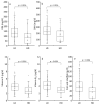Extent of Unidentified Complaints and Depression Is Inversely Associated with Fish and Shellfish Intake in Young Japanese Women
- PMID: 40219009
- PMCID: PMC11990306
- DOI: 10.3390/nu17071252
Extent of Unidentified Complaints and Depression Is Inversely Associated with Fish and Shellfish Intake in Young Japanese Women
Abstract
Background/Objectives: Vague physical complaints with no corresponding organic disease background are called unidentified complaints. The symptoms of patients with unidentified complaints closely resemble medically unexplained or persistent physical symptoms, with the onset sometimes masked by mental disorders. Over the past 50 years, numerous studies have connected unfavorable eating habits to these symptoms; however, no study has systematically examined the association between the symptoms and specific nutrients or food items. Methods: We conducted a cross-sectional study of young Japanese women, using questionnaire surveys, to assess their nutritional intake, quantify unidentified complaints and depression, and identify nutrients/food items primarily associated with the severity of these conditions. Results: Our findings indicate that participants with high scores for unidentified complaints, depression, or both had lower intake levels of eicosapentaenoic acid, docosahexaenoic acid, vitamin D, and vitamin B12 than those with low scores, alongside reduced fish and shellfish consumption. Notably, the median fish and shellfish intake in the group with high scores for both unidentified complaints and depression was less than one-fourth of that in the low-score group. Conclusions: The results align with previous findings, demonstrating a modest inverse association between fish intake and depression risk, and suggesting the involvement of fish and shellfish intake in the occurrence of unidentified complaints.
Keywords: depression; docosahexaenoic acid; eicosapentaenoic acid; food frequency questionnaire; medically unexplained symptoms; unidentified complaints; vitamin B12; vitamin D.
Conflict of interest statement
The authors declare no conflicts of interest.
Figures





Similar articles
-
Seafood Consumption, Omega-3 Fatty Acids Intake, and Life-Time Prevalence of Depression in the PREDIMED-Plus Trial.Nutrients. 2018 Dec 18;10(12):2000. doi: 10.3390/nu10122000. Nutrients. 2018. PMID: 30567286 Free PMC article. Clinical Trial.
-
Associations between healthy Japanese dietary patterns and depression in Japanese women.Public Health Nutr. 2021 May;24(7):1753-1765. doi: 10.1017/S1368980020001548. Epub 2020 Jul 17. Public Health Nutr. 2021. PMID: 32677609 Free PMC article.
-
Association between fish and shellfish consumption, n-3 polyunsaturated fatty acids, and gastric cancer risk: the Japan Public Health Center-based Prospective Study.Eur J Nutr. 2024 Aug;63(5):1529-1544. doi: 10.1007/s00394-024-03343-9. Epub 2024 May 4. Eur J Nutr. 2024. PMID: 38703225 Free PMC article.
-
Nutritional epidemiology of type 2 diabetes and depressive symptoms.J Epidemiol. 2013;23(4):243-50. doi: 10.2188/jea.je20130018. Epub 2013 Jun 8. J Epidemiol. 2013. PMID: 23748249 Free PMC article. Review.
-
Fish intake, contaminants, and human health: evaluating the risks and the benefits.JAMA. 2006 Oct 18;296(15):1885-99. doi: 10.1001/jama.296.15.1885. JAMA. 2006. PMID: 17047219 Review.
References
-
- Abe T. Psychosomatic View-point for the Unidentified Clinical Syndrome. Jpn. J. Psychosom. Med. 1979;19:5–13.
-
- Nanba A., Goto Y., Nakatsuka M., Okuda H., Ikeda T. General malaise in adolescents -Relation to menstruction and masculine characteristics- J. Jpn. Soc. Matern. Health. 2008;48:451–461.
-
- Noro S., Nakahata H., Kasai S. Background of unexpected physical symptoms of the middle age women. J. Jpn. Soc. Psychosom. Obstet. Gynecol. 1999;3:41–45.
-
- Takase S., Morimoto A., Shimura F., Hosoya K. Unidentified complaints and eating behavior. J. Jpn. Soc. Food Nutr. 1975;28:309–317.
-
- Watanabe Y., Kumagai M., Aoki H. Relationship with Evaluation of Unspecified Complaints and Eating Behavior in Female College Students. Jpn. J. Nutr. Diet. 1997;55:197–204. doi: 10.5264/eiyogakuzashi.55.197. - DOI
MeSH terms
Grants and funding
LinkOut - more resources
Full Text Sources
Medical
Miscellaneous

